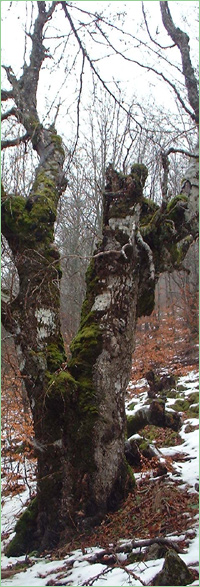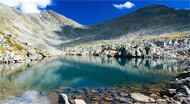Ostrovche (Unique identification code in the register: BG0000173)
Category: PZ under the Habitat Directive
Area: 6749.19 hectares Location:
1.
District: Razgrad, Municipality: Loznitsa, Locality: Gradina, Manastirsko, Seydol, Sinya voda, Studenets
2.
District: Razgrad, Municipality: Razgrad, Locality: Blagoevo, Ostrovche, Poroishte, Razgrad
3.
District: Targovishte, Municipality: Popovo, Locality: Drinovo, Elenovo, Lomtsi, Trastika
4.
District: Targovishte, Municipality: Targovishte, Locality: Krashno, Makovo, Miladinovtsi
Falls in the territory of the following Regional Inspectorates of Environment and Water (RIEW):
1.
Ruse - bul."Pridunavski" 20 p.k.26
2.
SHumen - ul."Syedinenie" 71 et.4
Ordinance for announcement:
Ordinance No.РД-1014 from 17.12.2020
2-2-173-1014-2020
Record for protected zone (link):

Aims of the declaration:
1. Protection and maintenance of natural habitats types under item 2.1, habitats referred to item 2.2. species, their populations and distribution within the area to achieve and maintain their favorable conservation status in Continental biogeographical region;
2. Increase the contribution of the protected area to the area of natural habitats with codes 6210 (*important orchid habitats) and 6430;
3. Improving the structure and functions of natural habitats with codes 6210 (*important orchid habitats), 6430, 9180 *, 91H0 *, 91I0 *, 91M0 and 91Z0;
4. Improvement of habitats of species Emys orbicularis, Triturus karelinii, Testudo hermanni, Testudo graeca;
5. If necessary, improvement of the condition or restoration of types of natural habitats refered in item 2.1, habitats of the species refered in item 2.2 and their populations.
Objects of protection (species or habitats):
1. Article 6, paragraph 1, section 1 from Biological Diversity Act: 6210 Semi-natural dry grasslands and scrubland facies on calcareous substrates (Festuco-Brometalia) (* important orchid sites) ;
6430 Hydrophilous tall herb fringe communities of plains and of the montane to alpine levels;
9170 Oak-hornbeam forestsGalio-Carpinetum;
9180 * Forests of slopes, screes and ravines Tilio-Acerion ;
91E0 * Alluvial forests with Alnus glutinosa and Fraxinus excelsior (Alno-Pandion, Alnion incanae, Salicion albae);
91H0 * Pannonian woods with Quercus pubescens;
91I0 * Euro-Siberian steppic woods with Quercus spp.;
91M0 Pannonian-Balkanic turkey oak –sessile oak forests;
91Z0 Moesian silver lime woods;
2. Article 6, paragraph 1, section 2 from Biological Diversity Act: Mammals - Canis lupus, Vormela peregusna;
Amphibians and reptiles - Bombina bombina, Triturus karelinii, Elaphe sauromates, Emys orbicularis,Testudo hermanni, Testudo graeca;
Fish - Cobitis taenia;
Intervertebrates - Lucanus cervus, Osmoderma eremita, Cerambyx cerdo, Morimus funereus, Rosalia alpina, Bolbelasmus unicornis, Lycaena dispar.
Current prohibitions and regimes:
1. It is prohibited conducting races with motor vehicles outside the existing roads;
2. It is prohibited movement of motorcycles, ATVs, UTVs and buggies off existing roads in non-urban areas. The prohibition does not apply to routes for the movement of the listed motor vehicles determined on the basis of a normative act, as well as in case of disasters, emergencies and for carrying out fire-fighting, emergency, control and rescue activities;
3. It is prohibited the prospecting for minerals (construction and stone materials), creating new and expanding concession areas for extraction of minerals (construction and stone materials); prohibition does not apply in cases where the date of publication of the order in the "Official Gazette" has started a procedure for granting permits for prospecting and / or exploration and / or the concession for extraction under Subsurface Resources Act (SRA) and Concessions Act, or a procedure for their coordination under Chapter Six of the Law on environmental protection and / or art. 31 of the Biological Diversity Act or an application for registration of a commercial discovery;
4. It is prohibited to change the way of permanent use, plowing, afforestation and conversion into permanent plantations of meadows, pastures and grassland, when using agricultural lands as such;
5. It is prohibited to plow and afforest meadows, barren lands and other unforested forest territories within the boundaries of non-forest natural habitats under item 2.1 except in cases of proven need for protection against erosion and flood rain, as well as in cases of implementation of eligible plans, programs, projects or investment proposals approved in accordance with environmental legislation;
6. It is prohibited to remove landscape features (borders, vital single trees and groups of trees, traditional strips occupied by shrub and tree vegetation among lands under cultivation, protective forest belts, stone fences and hedges), when using agricultural land as such, except in cases to removal of invasive alien species of trees and shrubs;
7. It is prohibited the use of fertilizers, soil improvers, biologically active substances, nutrient substrates and plant protection products that do not meet the requirements of the Plant Protection Act;
8. It is prohibited the use of mineral fertilizers in meadows, pastures, grasslands, abandoned agricultural lands and forest areas, as well as plant protection products of professional category of use in these areas except for calamity, epiphytosis or the use of selective methods to combat invasive alien species;
9. It is prohibited to use of organic sludge from industrial and other waters and household waste for introduction into agricultural land without permission from the specialized bodies of the Ministry of Agriculture, Food and Forestry and when the concentration of heavy metals, metalloids and persistent organic pollutants in sludge exceeds background concentrations according to Annex № 1 of Ordinance № 3 of 2008 on the norms for permissible content of harmful substances in soils (SG, issue 71 of 2008);
10. It is prohibited to use of irrigation water that contains harmful substances and waste above the permissible norms;
11. It is prohibited burning of stubble, syllables, roadside strips and areas with dry and moisture-loving vegetation;
12. It is prohibited extraction of wood and biomass in forests in the old age phase, except in cases of damage of more than 50% of the area of the respective forest in the old age phase due to natural disasters and calamities; in old age forests, through which existing forest roads and other infrastructure objects pass, if proven necessary, felling of single dry, damaged, endangered or obstructing the safe movement of people and vehicles or the normal functioning of infrastructure objects trees is allowed;
13. It is prohibited grazing of domestic animals in forest areas, which are designated for forests in the old age phase.
14. It is prohibited carrying out felling in natural habitat with code 91E0 *, except for the needs of facilities (elements) of the technical infrastructure, for prevention of dangers endangering human life and health, in case of disasters and accidents, for maintenance / improvement of natural habitats and habitats of the species under item 2;

|
|

|





